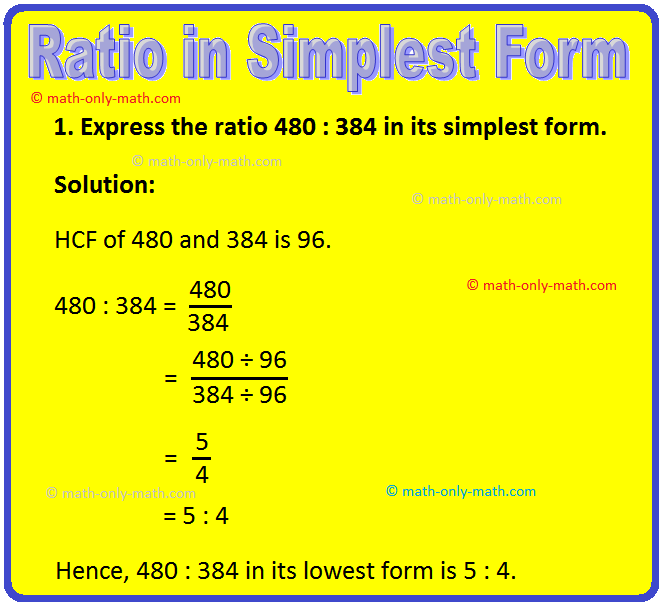Subscribe to our ▶️ YouTube channel 🔴 for the latest videos, updates, and tips.
Ratio in Simplest Form
Here we will learn how to make the ratio in simplest form.
Ratio in Simplest Form:
If the ratio a : b is such that the HCF of numerator a and denominator b is 1, then the ratio a : b is called the ratio in its simplest form.
A ratio should always be expressed in its simplest (lowest) form.
Properties of Ratio in Simplest Form:
1. A ratio between two quantities of same kind and in the same units is obtained on dividing one quantity by the other and has no unit. The ratio is independent of the units used in the quantities compared.
2. The ratio must always be expressed in its simplest form or in its lowest terms.
A ratio is said to be is the simplest form or in the lowest term if two quantities of a ratio (i.e., antecedent and consequent) have no common factor (i.e. antecedent and consequent are co-prime) other than 1 (or their HCF is 1.)
For example:
(i) The ratio between 36 kg and 24 kg
= \(\frac{\textrm{36 kg}}{\textrm{24 kg}}\)
= \(\frac{36}{24}\), [both numerator and denominator are divided by 12]
= \(\frac{3}{2}\)
= 3 : 2.
(ii) The ratio between 5 kg and 15 kg
= \(\frac{\textrm{5 kg}}{\textrm{15 kg}}\)
= \(\frac{5}{15}\), [both numerator and denominator are divided by 5]
= \(\frac{1}{3}\)
= 1 : 3.
3. If in a ratio the number or quantities are of the same kind but in different units, then we must convert them number or quantities into same unit. Generally, the bigger unit of the ratio is converted into smaller unit.
For example:
(i) The ratio between 800 g and 1.2 kg
= \(\frac{\textrm{800 g}}{\textrm{1200 g}}\)
= \(\frac{800}{1200}\), [since 1.2 kg = 1.2 × 1000 gm = 1200 gm]
= \(\frac{8}{12}\), [both numerator and denominator are divided by 4]
= \(\frac{2}{3}\)
= 2 : 3.
(ii) The ratio of 5 cm and 60 mm
= \(\frac{\textrm{50 mm}}{\textrm{60 mm}}\), [since 5 cm = 5 × 10 mm = 50 mm]
= \(\frac{50}{60}\), [both numerator and denominator are divided by 10]
= \(\frac{5}{6}\)
= 5 : 6.
4. If each term of a ratio is multiplied or divided by the same non-zero number (quantity), the ratio remains the same.
For example:
The ratio of 18 and 24 = 18 : 24 = \(\frac{18}{24}\)
Now, \(\frac{18}{24}\) = \(\frac{18 × 6}{24 × 6}\) = \(\frac{108}{144}\) or, 18 : 24 = 108 : 144.
Again, \(\frac{18}{24}\) = \(\frac{18 ÷ 6}{24 ÷ 6}\) = \(\frac{3}{4}\) or, 18 : 24 = 3 : 4.
5. The order of the quantities (terms) in a ratio (P : Q) is important. By reversing the antecedent and the consequent of a ratio, a different ratio is obtained (i.e., Q : P).
For example:
(i) The ratio 5 : 7 is different from the ratio 7 : 5.
(ii) 6 : 11 is different from 11 : 6.
The different types of examples along with the explanation will help us how we usually express the ratio in simplest form.
Solved Examples on Ratio in Simplest Form:
1. Convert the ratio 28 : 42 in its simplest form.
Solution:
HCF of 28 and 42 is 14.
28 : 42 = \(\frac{28}{42}\)
= \(\frac{28 ÷ 14}{42 ÷ 14}\)
= \(\frac{2}{3}\)
= 2 : 3
Hence, 28 : 42 in its simplest form is 2 :3.
2. Express the ratio 480 : 384 in its simplest form.
Solution:
HCF of 480 and 384 is 96.
480 : 384 = \(\frac{480}{384}\)
= \(\frac{480 ÷ 96}{384 ÷ 96}\)
= \(\frac{5}{4}\)
= 5 : 4
Hence, 480 : 384 in its lowest form is 5 : 4.
3. Find the ratio of 36 minutes to 3 hours.
Solution:
3 hours = 3 × 60 minutes = 180 minutes
36 minutes : 3 hours = 36 minutes : 180 minutes
= \(\frac{\textrm{36 minutes}}{\textrm{180 minutes}}\)
= \(\frac{36}{180}\)
= \(\frac{36 ÷ 36}{180 ÷ 36}\)
= \(\frac{1}{5}\)
= 1 : 5
4. Find the ratio of 4 years to 4 months.
Solution:
4 years = 4 × 12 months = 48 months
4 years : 4 months = 48 months : 4 months
= \(\frac{\textrm{48 months}}{\textrm{4 months}}\)
= \(\frac{48}{4}\)
= \(\frac{48 ÷ 4}{4 ÷ 4}\)
= \(\frac{12}{1}\)
= 12 : 1
Worksheet on Ratio in Simplest Form:
1. Express the following ratios as fractions and reduce them to the simplest form:
(i) 32 : 144
(ii) 16 : 640
(iii) \(\frac{1}{4}\) : \(\frac{3}{4}\)
Answer:
1. (i) \(\frac{2}{9}\)
(ii) \(\frac{1}{4}\)
(iii) \(\frac{\frac{1}{4}}{\frac{3}{4}}\)
6th Grade Page
From Ratio in Simplest Form to HOME PAGE
Didn't find what you were looking for? Or want to know more information about Math Only Math. Use this Google Search to find what you need.



New! Comments
Have your say about what you just read! Leave me a comment in the box below. Ask a Question or Answer a Question.